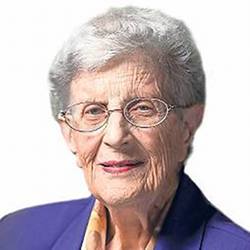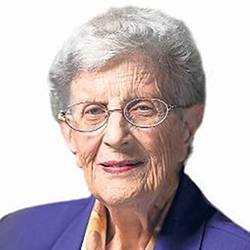
Jean E. Sammet, an American computer scientist who developed the FORMAC programming language and who served as the first female president of ACM, passed away May 21 at the age of 89.
Sammet was born in New York City on March 23, 1928; her parents, Ruth and Harry Sammet, were both lawyers. She and her sister Helen attended public elementary schools in Manhattan. She said she first became interested in mathematics "probably when I was seven years old. When I started the first grade, I immediately decided I liked that number stuff."
Despite her strong interest in mathematics, she was unable to attend the Bronx High School of Science because it did not accept girls; she attended instead the now-defunct all-girls Julia Richman High School, where she took every available math course.
After graduation, she enrolled at Mount Holyoke College, South Hadley, MA, based on the strength of its mathematics program. Sammet majored in mathematics and took education courses, which allowed her to be certified to teach high school mathematics in New York. After receiving a bachelor's degree in mathematics from Mount Holyoke in 1948, she pursued graduate studies at the University of Illinois at Urbana-Champaign while serving as a teaching assistant in the mathematics department. She received a master's degree in mathematics from that institution in 1949.
In 1951, Sammet left her position as a teaching assistant to pursue employment in education, but found that New York City schools were not hiring new teachers. When New Jersey schools also rejected her, saying her educational accomplishments lacked required courses in education and on the history of that state, she sought other avenues of employment.
Later that year, she took a position at the Metropolitan Life Insurance Company as a trainee actuary, where she agreed to participate in an in-house training program to learn about punched card accounting machines, and found that she loved it. When training was completed, however, she was sent back to her old job, and never even saw the big machines. She left that position to go back to school at Columbia University to pursue a doctorate in mathematics.
Sammet worked as a teaching assistant at Barnard College for the 1952-1953 school year, before deciding to leave the academic life. (While she did not complete her doctoral studies, she received an honorary doctor of science degree from Mount Holyoke College in 1978).
From 1953 to 1958, Sammet was a mathematician for Sperry Gyroscope (now part of Unisys) in New York, working on mathematical analysis problems for clients and running an analog computer. Sammet worked on the Department of the Navy's submarine program during her time there.
In early 1955, the company was working on a digital computer, the Sperry Electronic Digital Automatic Computer (SPEEDAC) and asked Sammet to be their programmer. Her first task was to write the basic loader for the SPEEDAC, which was a 20-line program that took three days to toggle into the computer by hand in binary.
As Sperry began hiring more programmers, Sammet became the group leader of what was called an "open shop" consisting of programmers acting as consultants to the engineers and working with scientists who assisted them in writing and testing their routines. The group, focused on scientific and engineering computations, also produced system software.
In 1955, the merger of Sperry Gyroscope and Remington Rand into Sperry Rand provided Sammet access to the first commercial computer produced in the U.S., the Universal Automatic Computer I (UNIVAC I).
In fall of 1956, Sammet taught one of the earliest graduate-level courses in computer programming in the Applied Mathematics department of Adelphi College (now University) on Long Island.
When Sammet decided in 1958 to leave Sperry to work for a company with computers as its focus, she found there were no relevant classified ads for such jobs for women (the classifieds at the time were segmented by gender). Scanning the ads for men, she found an open position for an engineer at Sylvania Electric Products in Needham, MA. Applying for the job, she was instead hired by Sylvania to oversee software development for the U.S. Army's Mobile Digital Computer (MOBIDIC).
Sammet served Sylvania as a staff consultant for programming research.
In 1959, Sammet was part of a group representing computer users, programmers, manufacturers, and universities, which asked the government to sponsor an effort to create a common business language. That led to a meeting at the Pentagon that resulted in the creation of several committees to identify the strengths and weaknesses of existing programming languages, prior to defining a new language. Sammet was part of the sub-committee formed to analyze existing languages (which also included William Selden and Gertrude Tierney of IBM, Howard Bromberg and Howard Discount of RCA, and Vernon Reeves of Sylvania). That sub-committee did most of the work creating the specifications for the new language, which were approved by the Executive Committee on January 3, 1960 and sent to the government printing office, which printed them as COBOL 60.
She left Sylvania to join IBM in 1961. During her years at IBM, she researched the use of restricted English as a programming language, as well as the use of natural language for mathematical programs. In 1965, she became programming language technology manager in the IBM Systems Development Division. Her book on programming languages, Programming Languages: History and Fundamentals, was published in 1969.
Sammet served as Programming Technology Planning Manager for IBM's Federal Systems Division from 1968 to 1974, and was named Software Technology Manager in 1979.
During the mid-1960s, Sammet developed FORMAC (Formula Manipulation Compiler), an early computer algebra system based on FORTRAN, which became the first widely used computer language for symbolic manipulation of mathematical formulas. During this period, she realized there was a need for the exchange of intellectual information with others working with languages and software. She was a member of ACM but not very active until then; she contacted ACM's then-president George Forsythe, who named her chairperson of the Special Interest Committee on Symbolic and Algebraic Manipulation (SICSAM, which became the Special Interest Group on Symbolic and Algebraic Manipulation, today's SIGSAM, in 1967).
With assistance from those interested in SICSAM, Sammet organized the first Symposium on Symbolic and Algebraic Manipulation (SYMSAM), which was held in March 1966.
In June 1966, Sammet was elected ACM's Northeast Regional Representative. She was also a member of the ACM Council, and was named ACM lecturer in 1967, 1968, and 1972. In August 1968, Sammet was named chairperson of the ACM Committee on SIGs and SICs.
In 1971 she was elected chair of the ACM Special Interest Group on Programming Languages (SIGPLAN), where she organized conferences between SIGPLAN and various other Special Interest Groups based on the recognition of how fundamental programming languages were to different aspects within computing. She served one year of a two-year term as SIGPLAN chair, before resigning because she was elected vice president of ACM in 1972.
Sammet served as vice president of ACM from June 1972 to June 1974. The president of ACM during that period, Anthony Ralston, asked Sammet to serve as chairman of the first ACM Long Range Planning Committee (LRPC).
In 1974, Sammet was elected the first female president of the ACM, and she continued to work with the LRPC. A final report from the committee was published in CACM in February 1975, recommending principles to be used as guidelines for future ACM activities.
Sammet worked to improve communication within the computing community, and within ACM. In her ACM President's Letter in the August 1975 issue of CACM, she wrote about "what I consider to be one of the strengths, and yet at the same time one of the difficulties of ACM: its very great diversity." Citing the large number of members in the organization (nearly 30,000, compared to more than 110,000 today), she observed the differing interests of the organization's members as researchers, practitioners, and students, and their diverse technical interests, as well as importance of the relationship of ACM to the "world outside," to national and international interests, and between member chapters and SIGs, "in the hope that each of us will obtain a better understanding of the other groups in ACM and what each person or group hopes to obtains, and/or has a right to obtain from the association."
In 1975, Sammet was inducted as an honorary member of Upsilon Pi Epsilon (UPE), the International Honor Society for the Computing and Information Sciences, an organization created "to recognize academic excellence at both the undergraduate and graduate levels in the Computing and Information Disciplines. "
In 1977, she organized the first History of Computing Committee for the American Federation of Information Processing Societies (AFIPS), and served as its chairperson. In addition to encouraging the creation of archives for materials, the committee publicized the importance of industry professionals' saving materials.
Said Sammet, "From childhood on, I hated to throw papers away. As I became an adult, this characteristic merged with my interest in computing history. As a result, I created important files and documents of my own, and became concerned with having other people publish material on their important work so the facts (rather that the myths) would be known publicly."
ACM celebrated Sammet in 1985 with its Distinguished Service Award, "for dedicated, tireless, and dynamic leadership in service to ACM and the computing community; for advancing the art and science of computer programming languages and recording its history.
Sammet officially retired from IBM in late 1988. In addition to consulting, she served on the board of directors of the Computer History Museum from 1983 to 1993, and on the board and executive committee of the non-profit Software Patent Institute from 1991 to 1998.
1n 1989, the Association for Women in Computing (AWC) chose Sammet to receive the Ada Lovelace Award, given to individuals who have excelled in either (or both) of two areas:
1. Outstanding scientific and technical achievement, and
2. Extraordinary service to the computing community through their accomplishments and contributions on behalf of women in computing,
In 1994, Sammet was part of the initial class of Fellows of the ACM, the most prestigious member grade recognizing "the top 1% of ACM members for their outstanding accomplishments in computing and information technology and/or outstanding service to ACM and the larger computing community."
In 1997, she shared SIGPLAN's Distinguished Service Award with J.A.N. Lee.
In 2001, Sammet was named a Fellow of the Computer History Museum "for her contributions to the field of programming languages and its history."
In 2009, IEEE named her recipient of its Computer Pioneer Award, "for pioneering work and lifetime achievement as one of the first developers and researchers in programming languages."
In 2013, the National Center for Women & Information Technology (NCWIT) bestowed its Pioneer Award on Sammet.
Sammet maintained an enormous collection of materials on programming languages, which were to be housed at the Charles Babbage Institute Center for the History of Information Technology at the University of Minnesota upon her demise.




Join the Discussion (0)
Become a Member or Sign In to Post a Comment